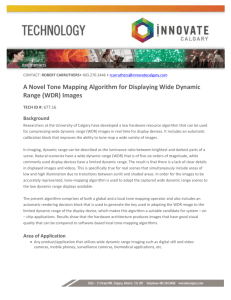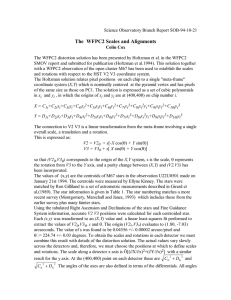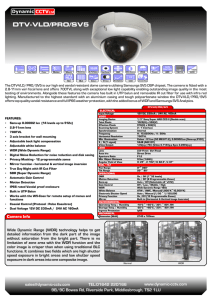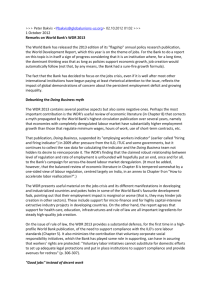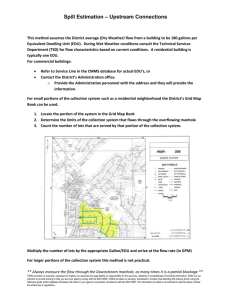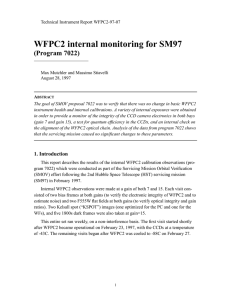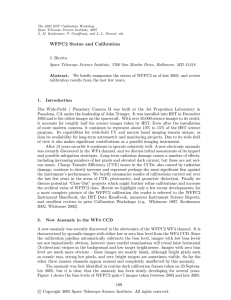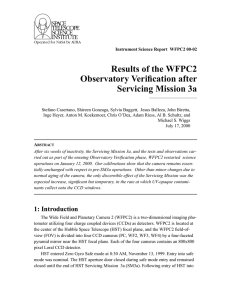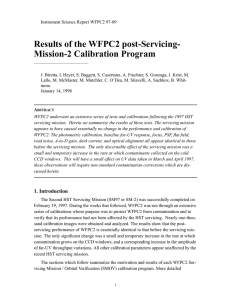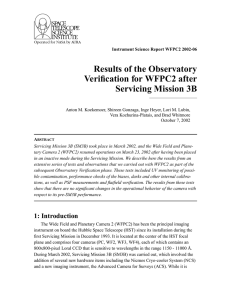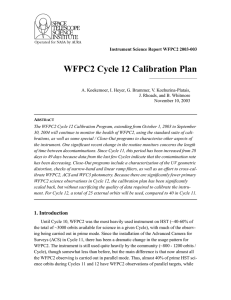Temperature Reductions to Mitigate the WF4 Anomaly
advertisement
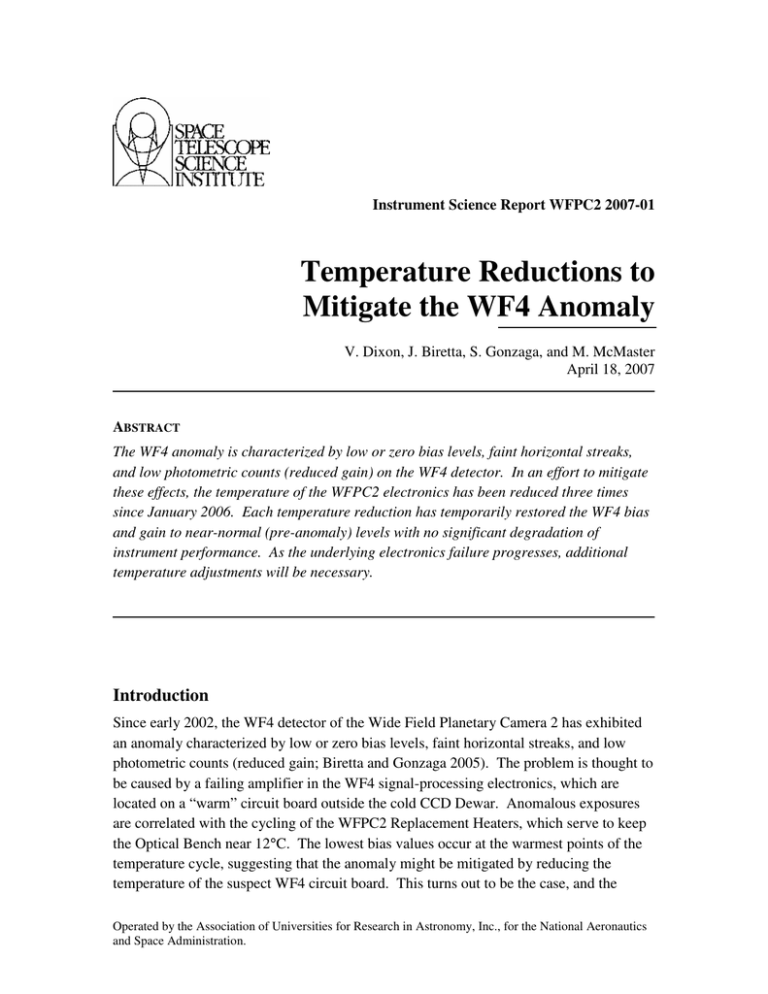
Instrument Science Report WFPC2 2007-01 Temperature Reductions to Mitigate the WF4 Anomaly V. Dixon, J. Biretta, S. Gonzaga, and M. McMaster April 18, 2007 ABSTRACT The WF4 anomaly is characterized by low or zero bias levels, faint horizontal streaks, and low photometric counts (reduced gain) on the WF4 detector. In an effort to mitigate these effects, the temperature of the WFPC2 electronics has been reduced three times since January 2006. Each temperature reduction has temporarily restored the WF4 bias and gain to near-normal (pre-anomaly) levels with no significant degradation of instrument performance. As the underlying electronics failure progresses, additional temperature adjustments will be necessary. Introduction Since early 2002, the WF4 detector of the Wide Field Planetary Camera 2 has exhibited an anomaly characterized by low or zero bias levels, faint horizontal streaks, and low photometric counts (reduced gain; Biretta and Gonzaga 2005). The problem is thought to be caused by a failing amplifier in the WF4 signal-processing electronics, which are located on a “warm” circuit board outside the cold CCD Dewar. Anomalous exposures are correlated with the cycling of the WFPC2 Replacement Heaters, which serve to keep the Optical Bench near 12°C. The lowest bias values occur at the warmest points of the temperature cycle, suggesting that the anomaly might be mitigated by reducing the temperature of the suspect WF4 circuit board. This turns out to be the case, and the Operated by the Association of Universities for Research in Astronomy, Inc., for the National Aeronautics and Space Administration. upper and lower set points of the Replacement Heaters have been reduced three times since January 2006. In this ISR, we document these temperature changes and their effects on both the WF4 anomaly and the overall performance of WFPC2. Temperature Changes The WFPC2 Replacement Heaters are used to stabilize the temperature of the Optical Bench and most other areas of the instrument. The temperature is regulated by an onboard computer that monitors the Bay 1 temperature. The heaters are powered on when the Bay 1 temperature falls below a lower set point, initially 10.9°C, and are powered off when an upper set point is reached, initially 14.9°C. By lowering these set points, it is possible to reduce the temperature of the WF4 camera head electronics, where the failing amplifier is located. Note that the CCD temperatures are not affected by these changes; they are maintained at -88°C by a separate system. The upper set point of the Replacement Heaters was lowered from 14.9° to 12.2°C on 9 January 2006 as an initial test of this mitigation strategy (Table 1). The experiment was successful, and the range of WF4 bias levels rose from 0 – 240 DN to about 150 – 270 DN for an analog-to-digital (A-to-D) gain setting of 7 e-/DN (Figure 1). Importantly, no significant changes in the optical alignment or image quality (discussed below) were observed. In February 2006, a second temperature reduction of ~1°C (Table 1) raised the bias range to 250 – 300 DN, with most images (> 95%) in the range 280 – 300 DN. The pre-anomaly bias level is ~ 311 DN. Unfortunately, these temperature reductions alleviate only the symptoms of the WF4 anomaly, not its root cause. As shown in Figure 1, the WF4 bias level fell throughout 2006 as the underlying electronics failure progressed. In March 2007, the temperature was lowered by another degree C, again restoring the bias to near-normal levels (Figure 2). Two more temperature reductions are planned for August 2007 and February 2008. Temperature Reduction / Date Lower Limit (°C) Upper Limit (°C) st Prior to 1 reduction 1st reduction: 9 January 2006 10.9 10.9 14.9 12.2 2nd reduction: 20 February 2006 3rd reduction: 27 March 2007 9.99 8.84 11.3 9.99 Table 1. Dates on which the temperature limits of the WFPC2 Replacement Heaters were reduced and the new limits established on each date. 2 Figure 1. CCD bias levels for WFPC2 images at A-to-D converter gain 7 as a function of time for the period 01/2003 through 4/2007. Temperature reductions occurred in 01/2006, 02/2006, and 03/2007. Each point represents one image. Note that the PC1, WF2, and WF3 bias levels are nearly constant across this time period. Effects on Instrument Performance Before and after each temperature adjustment, a series of calibration observations are performed to characterize the WFPC2 instrument performance. Bias and internal flatfield exposures, performed at A-to-D gain settings of both 7 and 15 e-/DN, track the bias level and provide a crude measure of the instrument sensitivity. So-called KSPOT images are also obtained. The KSPOTs (Kelsall spots) are transparent spots on the Pyramid Mirror that, when back-illuminated by a calibration lamp, provide a pattern of artificial stars whose images can reveal changes in the alignment of the instrument optics or the relative positions of the four CCDs. Approximately five days after the temperature change, a set of dark frames is obtained, followed by images of the globular cluster Omega Cen, which provide information on the instrument point-spread function and overall image quality. 3 Figure 2. CCD bias levels for WFPC2 images at A-to-D converter gain 7 vs. time for the period 3/9/2007 through 4/4/2007. The third temperature reduction occurred on 3/27/2007. As discussed above, temperature reductions have the desired effect on the WF4 bias levels. Flat-field exposures obtained after the temperature reduction show flux levels nearly identical to those obtained before the onset of the WF4 anomaly. The KSPOT images show small but measureable offsets that correlate with the temperature changes. These offsets, relative to the spot positions measured in 2002, are plotted in Figures 3 and 4. We see that each temperature reduction shifts the PC spots by ~ 0.2 pixel in x and ~ 0.1 pixel in the y direction. Similarly, the WF2, WF3, and WF4 spots show motions of up to ~ 0.1 pixel across each temperature change. The WF2 spots show somewhat smaller motions (~ 0.05 pixel), while on WF3 and WF4 the y component of motion dominates. The pixel scale on the PC chip is roughly half that of the wide field chips, so the motions in the four chips are roughly similar in units of arcseconds. In all cases, the direction of motion is consistent across the three temperature changes. 4 Figure 3. Measured positions of KSPOTs on the PC1 and WF2 CCDs relative to images taken in February 2002. 5 Figure 4. Measured positions of KSPOTs on the WF3 and WF4 CCDs relative to images taken in February 2002. 6 Date 11 Jul 2004 25 Feb 2006 1 Feb 2007 1 Apr 2007 Filter F555W F555W F814W F814W PC1 1.72 ± 0.02 1.72 ± 0.02 1.75 ± 0.03 1.76 ± 0.02 WF2 1.64 ± 0.01 1.45 ± 0.01 1.46 ± 0.02 1.46 ± 0.01 WF3 1.64 ± 0.01 1.53 ± 0.01 1.47 ± 0.02 1.41 ± 0.01 WF4 1.64 ± 0.01 1.50 ± 0.01 1.42 ± 0.02 1.46 ± 0.01 Table 2. Mean FWHM (in pixels) measured for stars in the globular cluster Omega Cen. The July 2004 data represent the period before the first temperature reduction, February 2006 and February 2007 represent the period between the 2nd and 3rd adjustments, and April 2007 follows the 3rd adjustment. Note that different filters are used for the first data sets and the 2007 data; all exposures are 100 seconds. Fits to individual stellar profiles in the Omega Cen images (Table 2) reveal that the width of the instrument point-spread function was actually reduced in the WF channels by the first set of temperature reductions (in January and February of 2006) and was little affected by the March 2007 temperature adjustment. While the KSPOT images show evidence for small changes in the optical alignment, the changes appear not to degrade the image quality significantly. Future Activities Reducing the WFPC2 temperature does not repair the root problem of the WF4 anomaly, which is the slow failure of some component in the CCD amplifier electronics. As the component failure progresses, the symptoms of WF4 anomaly will eventually reappear, and further temperature reductions will be needed to offset the progressing failure. As a result, we plan two more temperature reductions, probably in August 2007 and February 2008, before WFPC2 is decommissioned. A second effort involves modifications to CALWP2, the calibration program for WFPC2 images, to correct archival data for the WF4 anomaly. Two new program modules are envisioned: one to rescale WF4 images to correct for the lower gain of the failing amplifier, and a second to remove the stripes present in WF4 images obtained at low bias levels. These would eventually be installed in the WFPC2 calibration pipeline, so that all past and future data are automatically corrected. Finally, the slight shifts in the relative positions of the four cameras apparent in Figures 3 and 4 can be accounted for by updating the reference files for the WFPC2 geometry (i.e., the offset tables). These calibration efforts are currently under way. References Biretta, J. and Gonzaga, S. 2005, Early Assessment of the WF4 Anomaly (WFPC2 ISR 2005-02). 7
